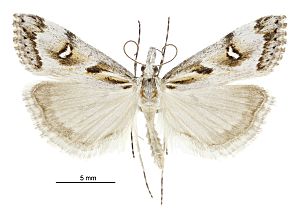Beaked moss moth facts for kids
Quick facts for kids Beaked moss moth |
|
|---|---|
 |
|
| Male | |
| Conservation status | |
 Nationally Vulnerable (NZ TCS) |
|
| Scientific classification | |
| Kingdom: | |
| Phylum: | |
| Class: | |
| Order: | |
| Family: | |
| Genus: |
Gadira
|
| Species: |
G. leucophthalma
|
| Binomial name | |
| Gadira leucophthalma (Meyrick, 1882)
|
|
| Synonyms | |
|
|
The beaked moss moth (scientific name: Gadira leucophthalma) is a special kind of moth that lives only in New Zealand. It's known for its unique appearance and is currently considered a "Nationally Vulnerable" species by the Department of Conservation. This means it needs our help to protect it.
Contents
Discovering the Beaked Moss Moth
Who First Found It?
This interesting moth was first described in 1882 by a scientist named Edward Meyrick. He found the first specimens in the Port Hills near Lyttelton, New Zealand. He originally gave it the name Thinasotia leucophthalma.
How Its Name Changed
Over the years, scientists have studied the beaked moss moth more closely. They sometimes move species into different groups as they learn more. In 1895, another scientist, George Hampson, placed it in the group Talis. Later, in 1973, David E. Gaskin finally assigned it to its current group, Gadira. The original specimen used to describe this moth is kept safe at the Natural History Museum, London.
Where the Moth Lives
New Zealand Home
The beaked moss moth is endemic to New Zealand. This means it's found nowhere else in the world!
Specific Locations
You can find this moth in certain parts of the Canterbury area. It has been seen in the Lyttelton hills, on Mount Gray, at Kaitorete Spit, and on the Banks Peninsula. It has also been recorded in Cloudy Bay.
What the Moth Looks Like
Similar Species
The beaked moss moth looks a lot like another moth called Gadira petraula. It can be tricky to tell them apart!
Key Differences
However, there are a few clues. The beaked moss moth is usually a bit larger. Also, the edges of its front wings are often lighter in color. Both male and female beaked moss moths can have different patterns on their wings. Female moths can also have different wing lengths.
Moth Life and Habits
When They Fly
Scientists have collected adult beaked moss moths at different times of the year. They've been found in March, April, December, and November. They are most commonly seen from March to April.
Day or Night?
This moth is usually active during the day. However, some have been caught at night using special UV lights. This suggests they might fly a bit at night too.
Where They Like to Live
Preferred Homes
The beaked moss moth loves to live in "foredunes." These are the sand dunes closest to the ocean.
Other Habitats
They have also been found in areas where there's a type of grass called bristle-grass, especially when moss is growing nearby.
What They Eat
Mystery Meals
Scientists don't yet know for sure what the caterpillars of the beaked moss moth eat. Their "host plants" (the plants they feed on) are still a mystery.
Possible Food
However, some scientists think that the larvae (caterpillars) might feed on moss. More research is needed to confirm this!
Protecting the Beaked Moss Moth
Conservation Status
The beaked moss moth is listed as "Nationally Vulnerable" under the New Zealand Threat Classification System. This means its population is decreasing, and it faces a high risk of becoming endangered if we don't protect it.
Why It Matters
Protecting species like the beaked moss moth is important for keeping New Zealand's unique environment healthy.

